What works well
It works as advertised
I tested the Metabones V adapter primarily with the Sony A7rIII and Canon 24-70mm f/2.8 II, as this is my preferred shooting setup. For comparison with how autofocus would function on a native Sony lens, I also shot with the Zeiss 55mm f/1.8 and Sony 24-240mm lenses.
While testing the adapter, I was blown away by the autofocus system’s speed and accuracy when using my Canon 24-70mm. Not only could I use most of the autofocus settings on the camera (with the exception of Zone area focus), but eye autofocus also worked extremely well. Even when shooting in continuous burst mode at 10 frames per second, there was no lag when using a Canon lens and the adapter.
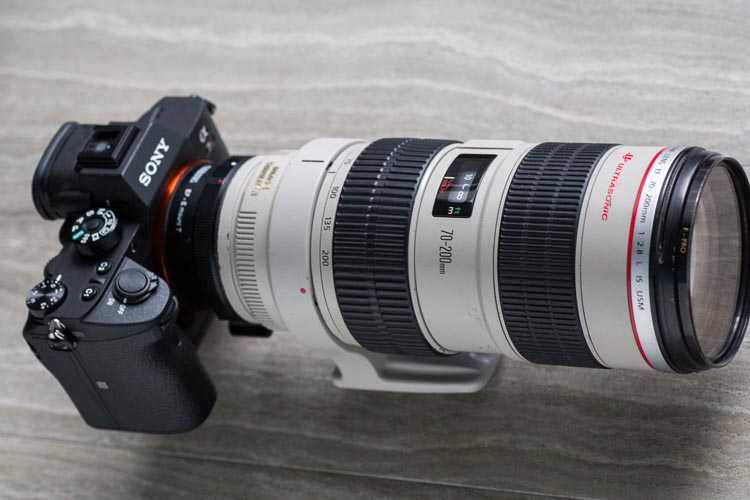
Generally speaking, it felt nearly the same as using a native Sony lens on the A7rIII. The same can’t be said for the cheaper FotodioX lens adapter that I was using previously. This other adapter worked with only half of my lenses and had inconsistent and slow autofocus. In that sense, you truly get what you pay for when it comes to camera gear (the FotodioX is $99 compared to the Metabones at $399).
Small and compact
Weighing in at 5.3 ounces (150g) and measuring 2.6 x 1.4 x 3 inches (6.6 x 3.6 x 7.6 cm), this slick adapter is compact and easy to stash in a camera bag. It feels about equivalent in size to the Canon 1.4X EF Extender. The Metabones V adapter comes in a plastic box that can you use for long-term storage, but unfortunately, there is no carrying case.
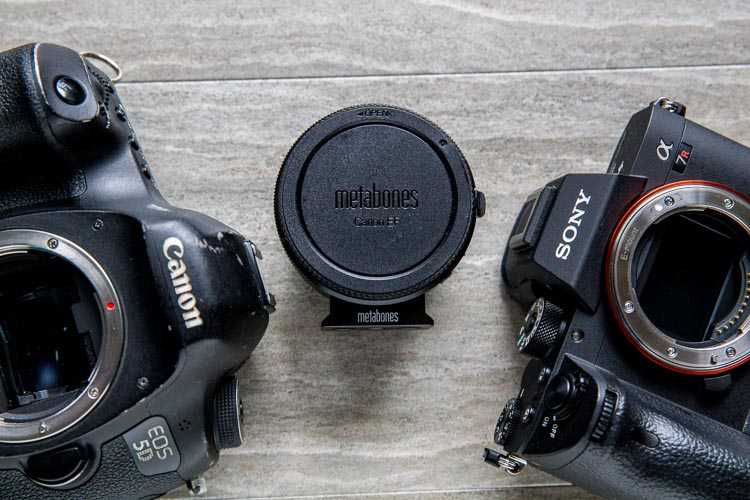
You can easily receive firmware updates
Besides a couple of buttons and indicator lights, there’s also a micro-USB port that can connect the adapter to a computer for firmware upgrades.
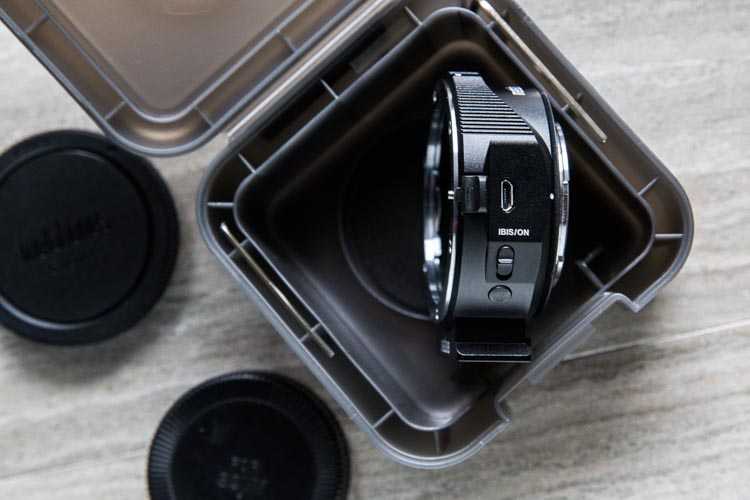
Product Specifications
The Metabones Canon EF to Sony E Mount Smart Adapter Mark V officially debuted in July 2017. It’s all black and made of metal. Compared to previous generation adapters, the Mark V adds three key features:
- A dedicated on/off switch for SteadyShot (IBIS)
- Rubber gasket weather seals to protect the E-mount connection
- An indicator light for basic/advanced modes
Other features offered by the Metabones V include:
- Fast contrast-detection and phase-detect autofocus
- Eye autofocus (!!)
- Powered by camera body (no external power source needed)
- Support of image stabilization lenses
- Auto “APS-C Size Capture” on full-frame cameras
Currently, theMetabones Adapter Mark V can be purchased for $399 USD.
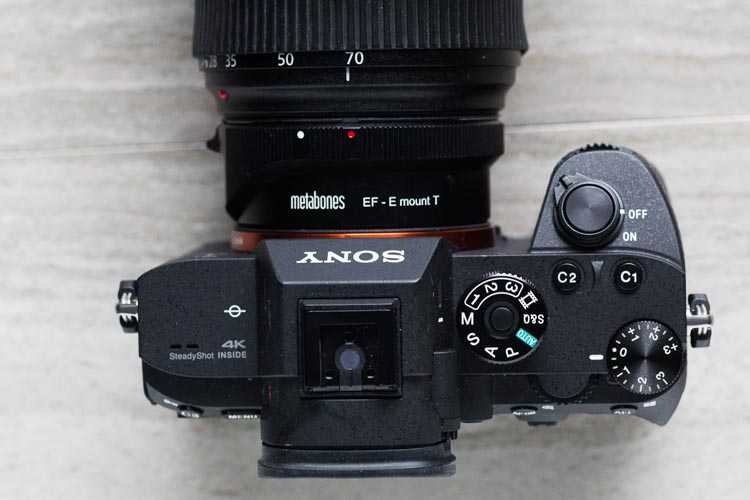
Here you see the adapter mounting a Canon EF lens onto a Sony body.
TOKINA EF LENSES (APS)
Tokina AT-X 116 PRO DX-II 11-16mm f/2.8 Lens for Canon Mount
Metabones: Not Yet TestedFotodiox: Not Yet TestedViltrox: Not Yet Tested
NOTES: Image Stabilization functions best with Metabones (with fw 0.41) on a7RII.
Tokina AT-X 11-20mm f/2.8 PRO DX Lens for Canon EF
Metabones: Not Yet TestedFotodiox: Not Yet TestedViltrox: Not Yet Tested
NOTES: Image Stabilization functions best with Metabones (with fw 0.41) on a7RII.
Tokina 12-28mm f/4.0 AT-X Pro APS-C Lens for Canon
Metabones: Not Yet TestedFotodiox: Not Yet TestedViltrox: Not Yet Tested
NOTES: Image Stabilization functions best with Metabones (with fw 0.41) on a7RII.
Performance
Ergonomics
The heavily knurled outside makes it easy to grab and mount and unmount, but during actual use it wears down the skin on the upper side of my middle finger with my big American hands.
The AF Lock button is a great idea, but it’s in a difficult place to reach.
Exposure
Exposure is fine.
This can be a problem with simpler adapters that don’t communicate the lens speed and confuse evaluative metering, but all seems fine here.
Falloff
Since there are no automated lens corrections, there will be no automated correction of lens falloff at large apertures to which you may be accustomed with Sony lenses.
Auto White Balance
Auto White Balance is fine.
On primitive adapters with no electronic communication this sometimes can be a problem, but with this modern electronic adapter everything works as intended.
Lateral Color Fringes
Since there are no automated lens corrections, there will be no automated correction of lateral color (corner color fringes).
If you use flawless lenses like the Canon Fluorite 300mm f/2.8 L this isn’t a problem, but if your lens has any of these color fringes, the camera won’t be correcting them for you as you may be accustomed with Sony’s own lenses.
Mechanical Quality
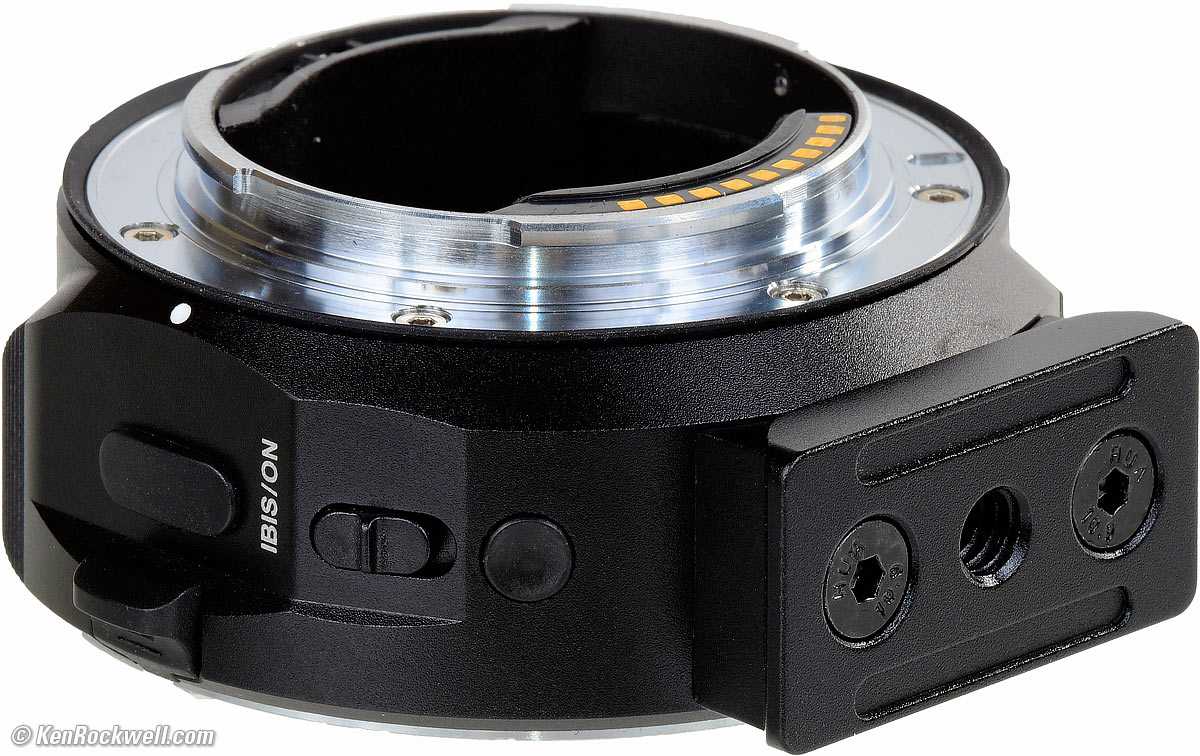
Metabones Canon EF to Sony E Mount Smart Adapter T Mark V. bigger.
It’s all metal.
Standard ¼″ × 20 thread.
Made in
China.
Sharpness
The adapter has no optics; it’s just air inside an empty barrel with electronics.
While the adapter does nothing to alter a lens’ performance, different brands of lenses may or may not work well on a Sony camera because of sensor particulars.
While film is sensitive to light that hits it from any angle, camera sensors are very particular with the arrangement of microlenses and light-sensitive wells, and different lenses may or my not appear sharp if you look at thngs under a microscope in the corners on a Sony camera, even if the lens is creating a flawless image. You have to try and conform for yourself.
Image Stabilization
If the Canon lens has IS, it will work.
If your Sony camera has sensor-shift stabilization, which most do, that works, too. You can turn this off and on easily with the slide switch on the adapter.
This adapter passes data.
Your files will have the focal length and aperture logged in the EXIF data.
I haven’t seen that the lens model is encoded in the EXIF data for any lens, so while the file will know it was shot at, say, 21mm, it won’t log if it was shot with a 12-24mm or 16-35mm lens, even if it’s a Sony lens with no adapter.
ZEISS ZE LENSES
Zeiss ZE lenses are manual focus lenses and no AF adapter will change that. Lens adapters communicate electronic functions like aperture and lens metadata – but these lenses remain manual focus – just the way Zeiss designed them:
Zeiss ZE 15mm f/2.8 Distagon T* Lens
Metabones: Manual focus lens – adapter provides electronic aperture controlFotodiox: Manual focus lens – adapter provides electronic aperture controlViltrox: Manual focus lens – adapter provides electronic aperture control
Zeiss ZE 18mm f/3.5 Distagon T* Lens
Metabones: Manual focus lens – adapter provides electronic aperture controlFotodiox: Manual focus lens – adapter provides electronic aperture controlViltrox: Manual focus lens – adapter provides electronic aperture control
Zeiss ZE 21mm f/2.8 Distagon T* Lens
Metabones: Manual focus lens – adapter provides electronic aperture controlFotodiox: Manual focus lens – adapter provides electronic aperture controlViltrox: Manual focus lens – adapter provides electronic aperture control
Zeiss ZE 25mm f/2.0 Distagon T* Lens
Metabones: Manual focus lens – adapter provides electronic aperture controlFotodiox: Manual focus lens – adapter provides electronic aperture controlViltrox: Manual focus lens – adapter provides electronic aperture control
Zeiss ZE 28mm f/2.0 Distagon T* Lens
Metabones: Manual focus lens – adapter provides electronic aperture controlFotodiox: Manual focus lens – adapter provides electronic aperture controlViltrox: Manual focus lens – adapter provides electronic aperture control
Zeiss ZE 35mm f/2 Distagon T* Lens
Metabones: Manual focus lens – adapter provides electronic aperture controlFotodiox: Manual focus lens – adapter provides electronic aperture controlViltrox: Manual focus lens – adapter provides electronic aperture control
Zeiss ZE 50mm f/1.4 ZE Planar T* Lens
Metabones: Manual focus lens – adapter provides electronic aperture controlFotodiox: Manual focus lens – adapter provides electronic aperture controlViltrox: Manual focus lens – adapter provides electronic aperture control
Zeiss ZE 50mm f/2 Makro-Planar T* Lens
Metabones: Manual focus lens – adapter provides electronic aperture controlFotodiox: Manual focus lens – adapter provides electronic aperture controlViltrox: Manual focus lens – adapter provides electronic aperture control
Zeiss ZE 85mm f/1.4 ZE Planar T* Lens
Metabones: Manual focus lens – adapter provides electronic aperture controlFotodiox: Manual focus lens – adapter provides electronic aperture controlViltrox: Manual focus lens – adapter provides electronic aperture control
Zeiss ZE 100mm f/2 Makro-Planar T* Lens
Metabones: Manual focus lens – adapter provides electronic aperture controlFotodiox: Manual focus lens – adapter provides electronic aperture controlViltrox: Manual focus lens – adapter provides electronic aperture control
Zeiss ZE 135mm f/2 Apo Sonnar T* Lens
Metabones: Manual focus lens – adapter provides electronic aperture controlFotodiox: Manual focus lens – adapter provides electronic aperture controlViltrox: Manual focus lens – adapter provides electronic aperture control
Key Features
![]()
| Features and benefits | Limitations | |
|
Metabones Exclusive
Electronic
Optical/mechanical
|
Autofocus
Other
|
Enhancement on new MARK IV (MB_EF-E-BT4) vs. old MARK IV (MB_EF-E-BM4):
The inner opening is lined with flocking material coating. This will further reduce internal reflection when a tilt-shift (TS) lens is used.
Disclaimer: we are NOT licensed, approved or endorsed by Sony or Canon.
Compatibility
This adapter works with . It doesn’t work with any of .
It works with Canon EF (use the red index dot) and EF-S (use the white index dot) lenses.
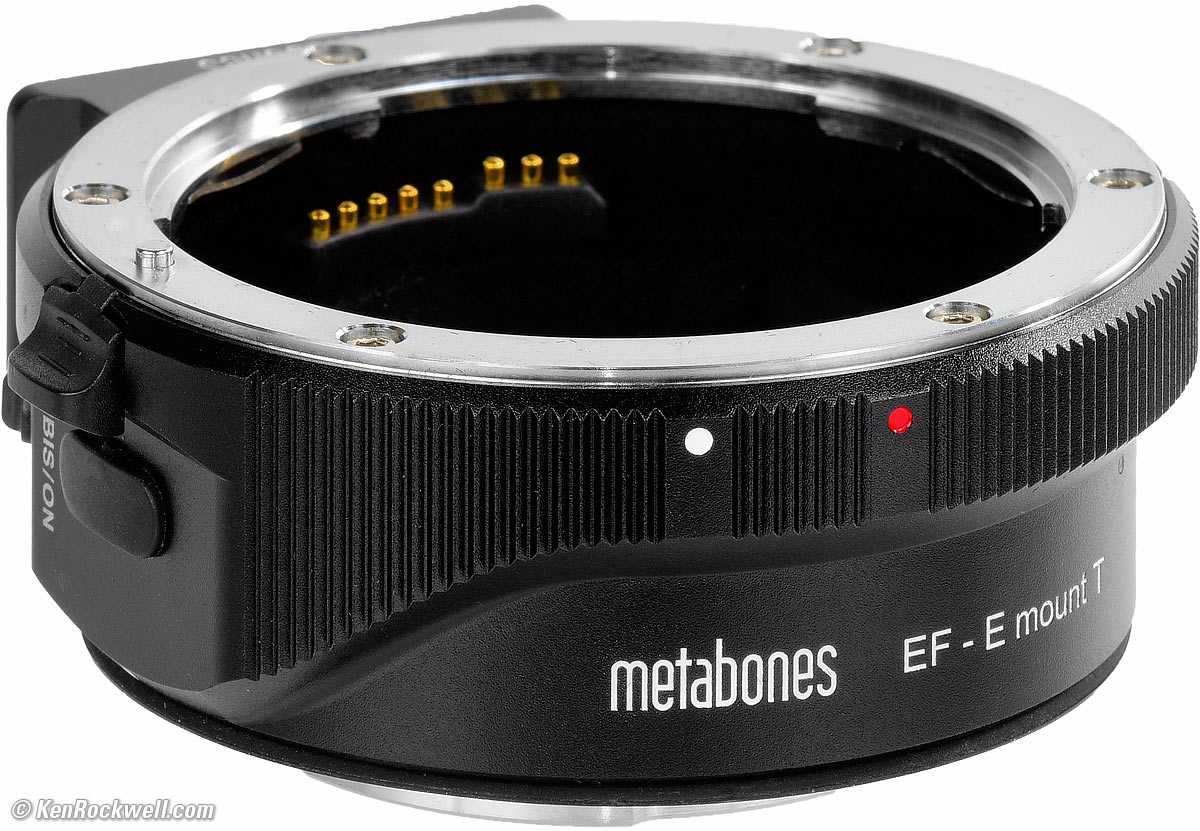
Metabones Canon EF to Sony E Mount Smart Adapter T Mark V. bigger.
I tried it with my Sony A9 and these lenses:
Canon 16-35mm f/4 L IS

Scene, 07 July 2017. bigger or full-resolution file.
I’m impressed, it’s actually super-sharp, which is nearly unheard of with adapted ultrawide lenses.
Both the lens’ own IS and the camera’s sensor-shift stabilization work great together.
AF works fine.
Canon 24-70mm f/2.8 L II

Palm, 07 July 2017. bigger or full-resolution file.
Again impressive is that this combination is pretty sharp and focuses well, and you get the benefit of in-camera stabilization.
This sample is shot wide-open at f/2.8, so of course the lower corner and other things aren’t in focus.
Canon 28-105mm USM II

Ryan at the orthodontist, 06 July 2017. Sony A9 with Canon 28-105mm USM II on Metabones Mark V adapter at 1/125 at Auto ISO 320. bigger or full-resolution file.

Katie at the orthodontist, 06 July 2017. Sony A9 with Canon 28-105mm USM II on Metabones Mark V adapter at 1/125 at Auto ISO 320. bigger or full-resolution file.
This 1990s lens usually works well, picking up free in-camera stabilization, but for whatever reason the camera doesn’t always recognize the lens immediately. Some times I’ll see an » F — — » indication in the finder instead of a real aperture. Even then it still shoots, but at God knows what aperture.
As you can see even with this used $75 lens, it gives super-sharp pictures.
Canon 35mm f/1.4 L
Everything seems swell with my 35/1.4, picking up free stabilization in the process.
As with most Canon lenses if you’re shooting in silent mode, you may hear a slight tick as the diaphragm stops down for each shot.
Canon 50mm f/1 L

Plant, 07 July 2017. bigger.
While everything works with my classic ultra-ultraspeed f/1.0 lens, autofocus performance isn’t very good. AF isn’t very fast and can tend to get lost, and it’s not very accurate.
Manual focus works swell, and of course this lens is incredible in the dark.
For the best results, focus manually or use the Canon 50mm f/1.2 L instead:
Canon 50mm f/1.2 L
It works great with Canon’s current ultra-speed lens — a faster lens than anything current from Sony or Nikon or ZEISS. It focuses well and it’s sharp, and you get free image stabilization.
It works fine with this old, cheap 1990s lens, again adding sensor-shift stabilization
It’s reasonably sharp, too.
Canon 100-400mm IS L II

Katie at Get Air, 18 July 2017. Sony A9 with Canon 100-400mm L IS II on Metabones Mark V adapter at 227mm at f/5 at 1/500 at Auto ISO 8,000, Perfectly Clear. bigger.

Palm, 07 July 2017. bigger or camera-original file.
I’m impressed again; this state of the art lens is super-sharp on my Sony, and it focuses well.
The stabilizers in-camera and in-lens work well; I’ve hand-held this tele at 1/20 of a second!
While AF works well, it doesn’t work as well as this lens works on a Canon camera. As adapted to Sony, it sometimes can hang-up or get lost if you’re far out of focus, while on a Canon camera it never gets lost. If it gets stuck, just grab the big focus ring to get it in the neighborhood, and the Sony’s AF will take it from there and track just fine.
Canon 300mm f/2.8 L
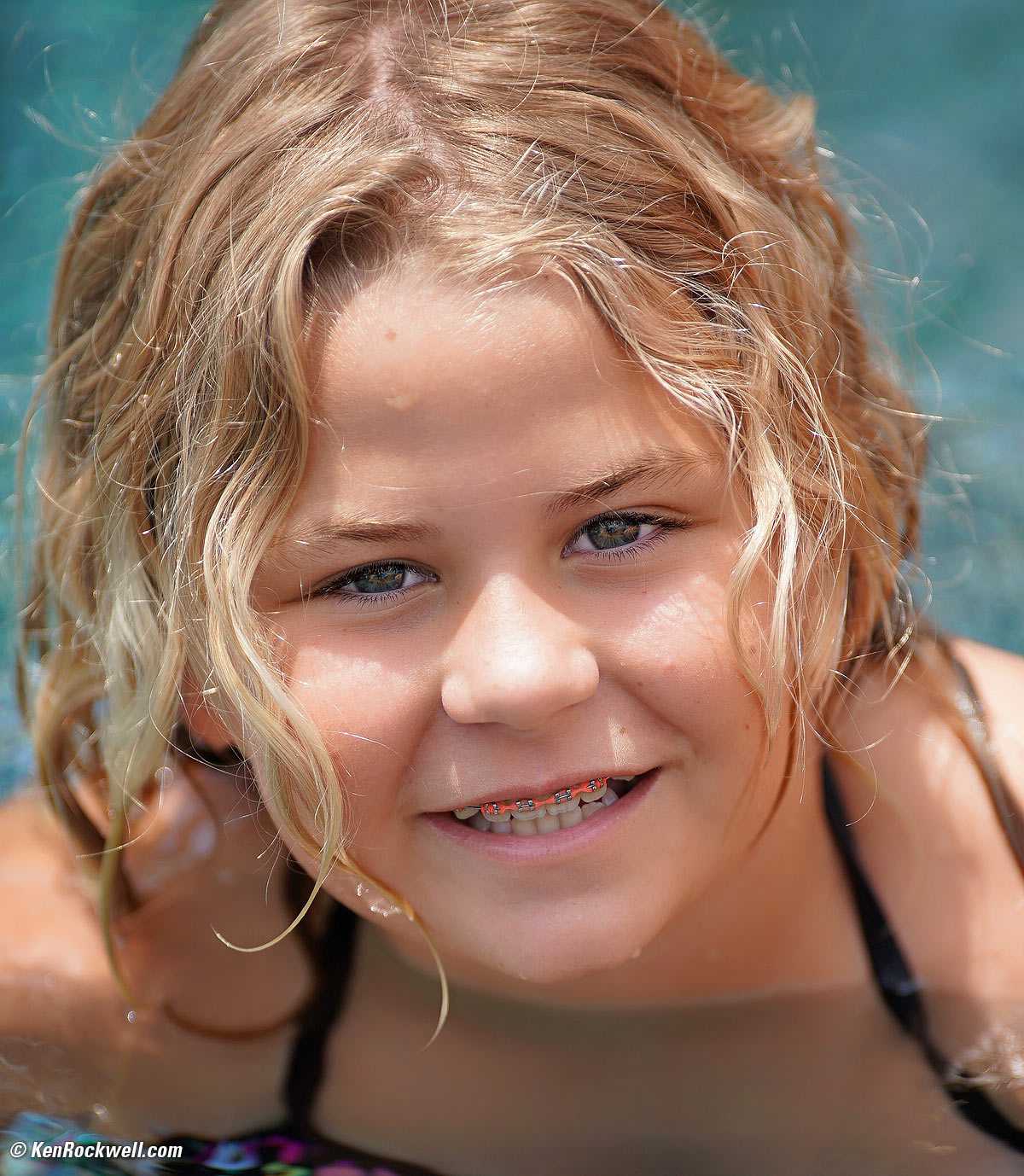
Katie in the pool, 06 July 2017. Sony A9 with Canon 300mm f/2.8 L on Metabones Mark V adapter at f/2.8 at 1/1,250 at Auto ISO 100. bigger or full-resolution file.
My classic 1980s fluorite 300/2.8 works GREAT! It’s ultra-sharp and focuses well, and I get free stabilization in-camera. Ha!
While AF can get lost if it’s far out of focus, in actual use where you have the focus not that far off, it’s amazing how well this classic lens works and tracks focus and gives ultrasharp after ultrasharp image at f/2.8 on the newest Sony camera.
What needs improving
For all of the excellent qualities of the Metabones V adapter, there are two shortcomings worth mentioning.
First is the occasional freezing of the camera screen while trying to autofocus. You can fix the problem by simply turning the camera off and on. However, this lag slows down your workflow and makes you question reliability. This problem happens sporadically, mostly with my Canon 24-70mm f/2.8 II, but it never happens when using native Sony lenses.
Another shortcoming is the loss of touchscreen autofocus when using a Canon lens and the Metabones V adapter. One of the biggest selling points of new Sony cameras such as the A7rIII is touchscreen autofocus. While it’s a bit laggy and imperfect even when using Sony lenses, touchscreen autofocus seems to disappear altogether when using adapted lenses. Hopefully, this will be fixed with future a firmware update.
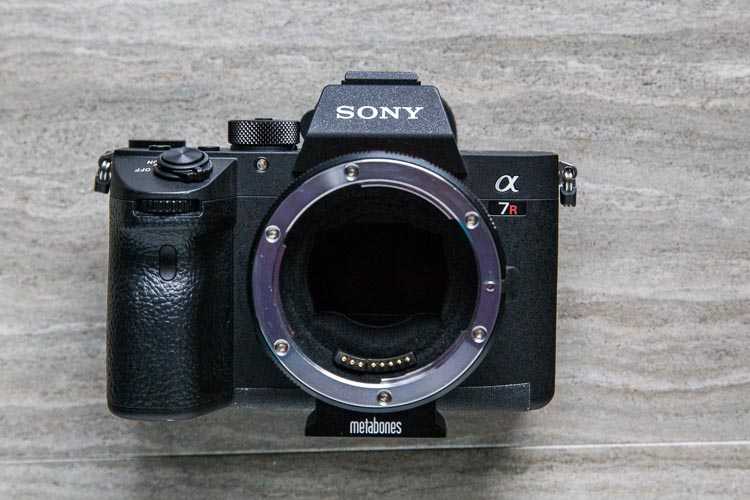
Recommendations
This is the best adapter I’ve used. My Canon lenses usually focus very well, are usually very sharp, and every crazy lens I tried worked. On other brands of adapters, like Fotodiox, some of my lenses wouldn’t work.
Adapters for Sony were critical back in 2013 when the first full-frame A7 came out and Sony had few, if any, serious lenses available.
Today Sony has a , so ideally get the Sony lens you want and it will work even better than an adapted lens. Canon lenses are awesome when shot on Canon cameras, but ultimately a Sony GM lens will work better on Sony than an adapted Canon lens.
Sony’s lenses are optimized for the AF systems and sensors of the Sony cameras, so they will focus faster than an adapted lens, and likewise Canon’s lenses may be ultrasharp on Canon, but they may or may not be ultrasharp when shot on the Sony sensors which require slightly different optical designs. Sony’s GM lenses are always ultra sharp on Sony cameras.
With adapters, your camera may take longer to turn on as the lens, adapter and camera computers try to figure out what’s going on. You may or may not get the super-fast turn-on you get with Sony’s own lenses on an A9, for instance.
Ultimately if this $400 adapter lets you reuse an exotic lens you already own or isn’t available from Sony, like a 300mm f/2.8, this adapter makes a lot of sense. However, if all you’re doing is trying to delay the inevitable, which is manning-up and just buying the real pro Sony lenses for your Sony camera that you know you really want, just get the Sony lenses you deserve. The smart money is always on getting the best lenses you want.
If you’re wondering how well any of your lenses will work on your camera, no worries. Get your Mark V adapter from Adorama, Amazon or B&H and you can simply return it for a cash refund if you don’t love it. There’s no reason to guess when you can try it yourself with you own equipment.
This all-content, junk-free website’s biggest source of support is when you use those or any of when you get anything, regardless of the country in which you live. I use the stores I do because they ship from secure remote warehouses where no one gets to touch your new camera before you do. Buy only from the for the best prices, service, return policies and selection.
Thanks for helping me help you!
Ken, Mrs. Rockwell, Ryan and Katie.
Ken Rockwell. All rights reserved. Tous droits réservés. Alle Rechte vorbehalten.
Conclusion:
Each of the three adapters performed slightly better with certain lenses yet the overall performance was fairly comparable. The $100 adapters from Fotodiox and Viltrox look identical but the results while close were not identical so it’s possible they are idenical in construction but with different firmware. I had to tighten the lens mount screws on the Viltrox repeatedly over the course of testing. If this happens to you I suggest applying a dab of Loctite on the screw threads (clear nail polish will do in a pinch) then tightening down firmly with a jewelers Phillips head screw driver.
As I said in the introduction, Metabones Smart Adapter IV with (Firmware 0.41 and later) is the only adapter that allows you to use the lens IS switch to choose between using lens-based optical Image Stabilization and Sony a7II/a7RII IBIS. Firmware on the Fotodiox and Viltrox adapters is not user-updatable.
Because of this I recommend that anyone who plans to use Canon IS lenses on Sony a7II or a7RII cameras stick to Metabones. But if you never plan to use Canon IS lenses on Sony IBIS cameras such as a7II and a7RII you can save yourself a few hundred dollars with Fotodiox or Viltrox.
Acknowledgements:
Huge thanks to my friends at B&H Photo, Menashe Wodinsky, Jesica Bruzzi, Michael Hollender, Yosef Brown and all the nice folks behind the counter in the new and used departments at B&H for their assistance in compiling this report. You guys ROCK!
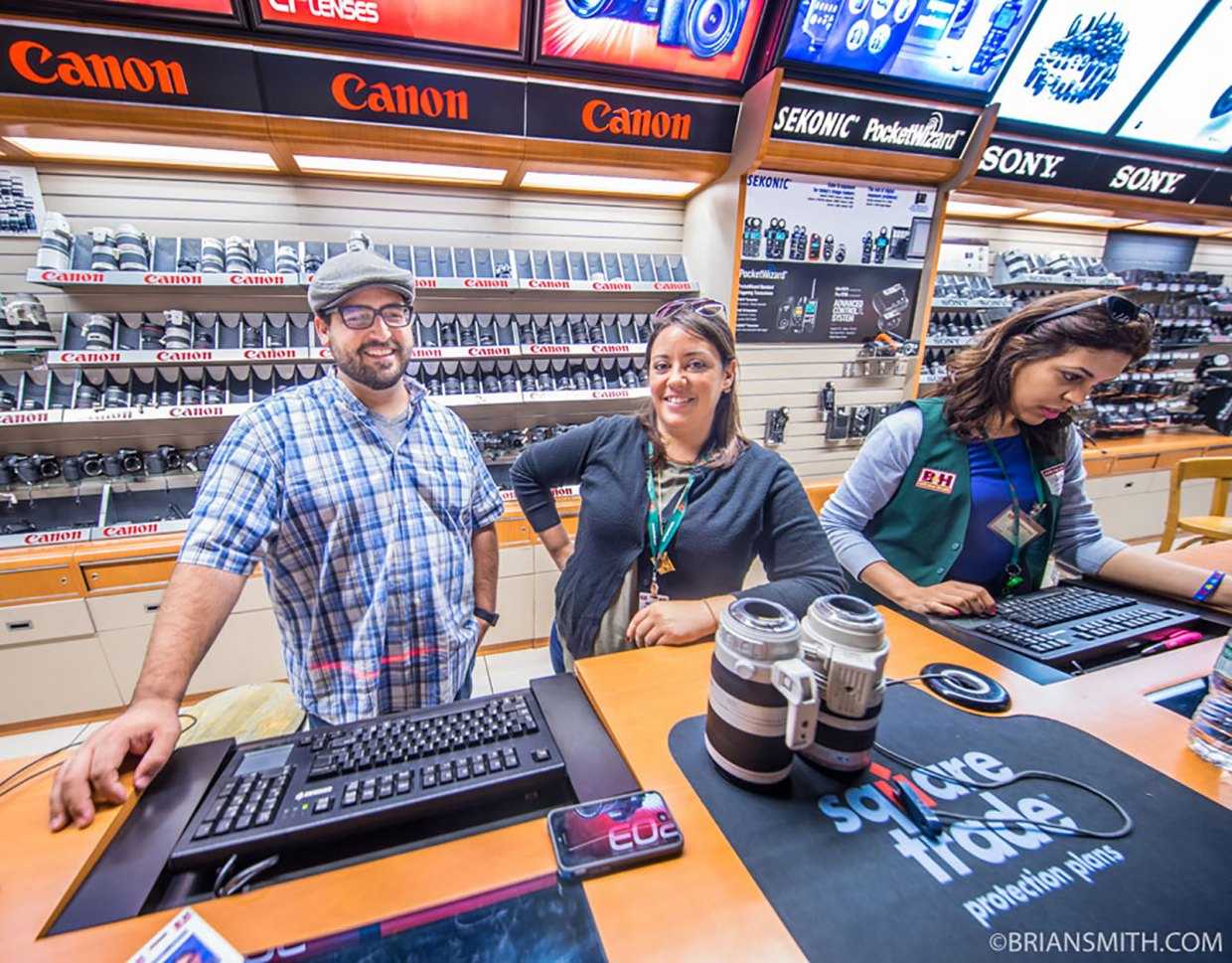
 For more tips and tricks about getting the most out of your Sony a7 series camera, check out my book ‘Sony a7-Series: From Snapshots to Great Shots’. It’s your guide to all of the Sony a7 Series I & II cameras. While the camera manual explains what the camera can do, it doesn’t show how to use the camera to create great images! Starting with the Top Ten things users need to know about the cameras, author Brian Smith, a Pulitzer Prize-winning photographer and Sony Artisan of Imagery, carefully guides you through the operating features of Sony a7, a7R, a7S, a7II and a7RII and how to use them. Get practical advice from a pro on which settings to use when, great shooting tips, and assignments at end of chapter to practice what you’ve just learned.
For more tips and tricks about getting the most out of your Sony a7 series camera, check out my book ‘Sony a7-Series: From Snapshots to Great Shots’. It’s your guide to all of the Sony a7 Series I & II cameras. While the camera manual explains what the camera can do, it doesn’t show how to use the camera to create great images! Starting with the Top Ten things users need to know about the cameras, author Brian Smith, a Pulitzer Prize-winning photographer and Sony Artisan of Imagery, carefully guides you through the operating features of Sony a7, a7R, a7S, a7II and a7RII and how to use them. Get practical advice from a pro on which settings to use when, great shooting tips, and assignments at end of chapter to practice what you’ve just learned.
‘Sony A7 Series: From Snapshots to Great Shots’ is available NOW from Amazon
Description
![]()
Tested Camera Bodies:
-
PDAF support *
A9 II, A9, A7R IV, A7R III, A7S III, A7III, A7R II, A7II, A6600, A6500, A6400, A6300
* Contax N lenses are not compatible with contrast-detection autofocus mirrorless cameras — no AF support for E-Mount cameras other than the models listed above.
-
IBIS support (full 5-axis in-body image stabilization) **
A9 II, A9, A7R IV, A7RIII, A7III, A7RII, A7II, A7SIII, A6600, A6500
** The Contax 645 Makro-Planar 4/120 lens does not report distance information and supports only 3-axis in-body image stabilization
Lens Compatibility Chart
| The following Contax N mount lenses are supported and tested: |
In addition, the following Contax 645 lenses, adapted to Contax N-mount by Contax NAM-1 adapter (not included), are supported and tested |
|
Vario-Sonnar T* 2,8/17-35 Vario-Sonnar T* 3,5-4,5/24-85 Vario-Sonnar T* 3,5-5,6/28-80 Vario-Sonnar T* 3,5-4,5/70-200 Vario-Sonnar T* 4-5,6/70-300 Planar T* 1,4/50 Planar T* 1,4/85 Makro-Sonnar T* 2,8/100 Apo-Teletessar T* 4/400 |
Vario-Sonnar T* 4,5/45-90 Distagon T* 3,5/35 Distagon T* 2,8/45 Distagon T* 3,5/55 Planar T* 2/80 Apo-Makro-Planar T* 4/120 Sonnar T* 2,8/140 Sonnar T* 4/210 Apo-Teletessar T* 4/350 Mutar 1.4x T* |
Why Metabones?
Since its inception, Metabones has been designing and manufacturing lens adapters recognized among professionals and enthusiasts as leaders in design and workmanship.
Contrary to the popular trend of other factories using an aluminum ring painted black on the camera-body-side, we instead take no short-cut but use precision-machined brass with chromium plating on both the camera-body and the lens sides of our adapters, in order to ensure smooth mounting, great appearance, and durability. The lens side of the adapter features a strong leaf-spring structure, strengthening the adapter-lens connection and ensuring tightness of the lens in order to reduce wear and prevent focus errors and optical alignment issues from appearing.
Metabones uses matte-black treatment to keep internal reflection to a minimum in order to maintain the maximum optical quality possible with the lens.
All Metabones Adapters follow this tradition of uncompromising precision, robust build quality and outstanding finish. Our new Smart AdapterTM series of products add industry-leading electronic interfacing technology from Canada, with true electronic control of the lens’ aperture directly from the camera body.
Features
- Both camera-side and lens-side of the adapter are made of brass, precision-machined and plated with chromium.
- Satin surface finish — just like your OEM lens and camera mounts.
- Precise fit and solid connection — lens has no play, gap or wiggling when mounted on adapter and no adjustments are required to fit your lens.
- Designed to reach infinity focus while maintaining the correct registration distance required to maintain optical quality of CRC lenses or lenses with floating elements.
Our Smart AdapterTM series adapters have the following additional features
- True electronic integration of aperture diaphragm — let camera automatically choose aperture in P or S exposure modes, or dial in yourself on the camera body in A or M modes.
- EXIF data such as lens identification, focal length and aperture.
CANON EFS LENSES
Canon EFS lenses are APS format with a very hard vignette edge making them suitable for Sony APS cameras like a6000, a5100, a5000 and NEX – but will only cover APS-crop mode on a7-series cameras.
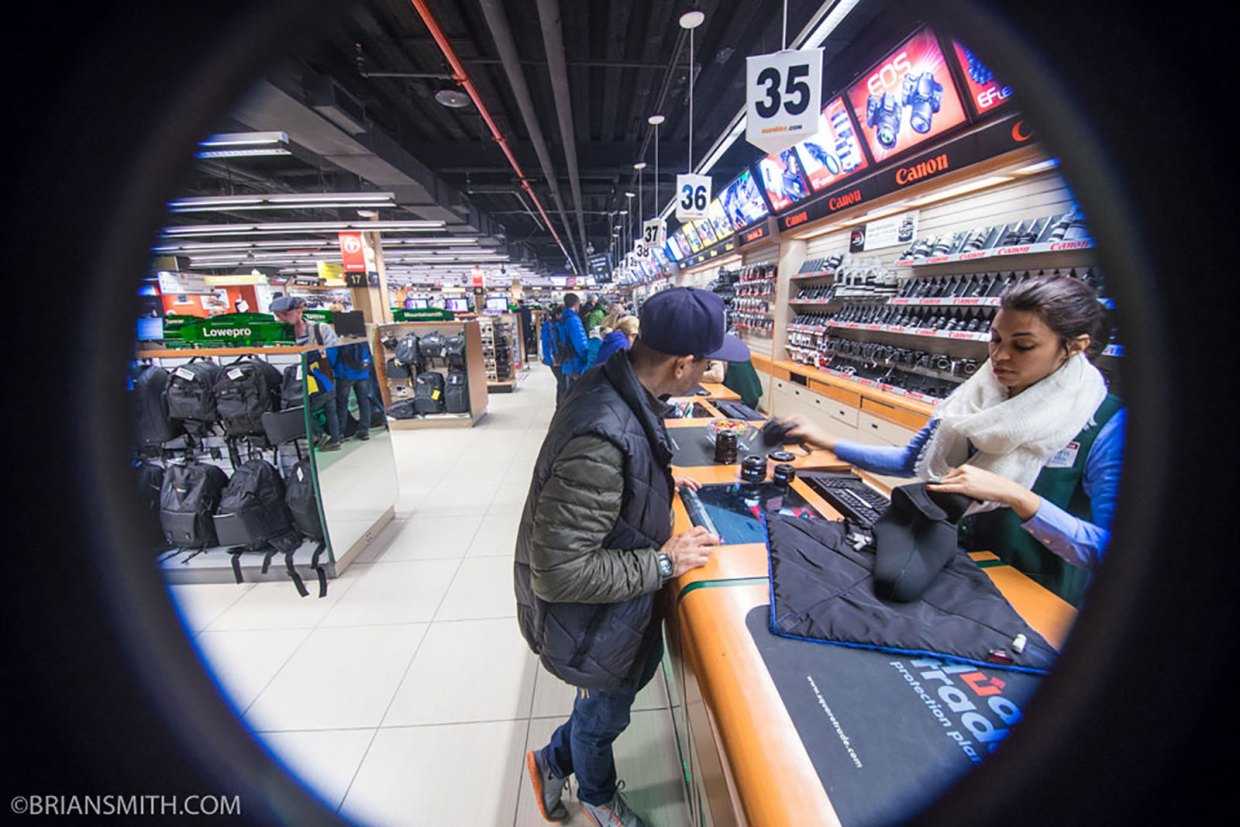
Canon EF-S 24mm f/2.8 STM Lens (APS-C)
Metabones: Accurate AF-S with Wide, Center and Flexible Spot Focus AreasFotodiox: Accurate AF-S with Wide, Center and Flexible Spot Focus AreasViltrox: Accurate AF-S with Wide, Center and Flexible Spot Focus Areas
Canon EF-S 17-55mm f/2.8 IS USM Lens (APS-C)
Metabones: Accurate AF-S with Wide, Center and Flexible Spot Focus AreasFotodiox: Accurate AF-S with Wide, Center and Flexible Spot Focus AreasViltrox: Accurate AF-S with Wide, Center and Flexible Spot Focus Areas
CANON TELECONVERTERS
Canon EF Extenders transmit electronic functions with all three Smart Adapters but with the accompanying light loss you may also lose AF with certain lenses.
Canon Extender EF 1.4x III + Canon EF 70-200mm f/2.8L IS II USM Lens
Metabones: Offers the fastest AF-S with Wide, Center and Flexible Spot Focus AreasFotodiox: Accurate AF-S with Wide, Center and Flexible Spot Focus AreasViltrox: Accurate AF-S with Wide, Center and Flexible Spot Focus Areas
Canon Extender EF 1.4x III + Canon EF 70-200mm f/4L USM
Metabones: Manual focus onlyFotodiox: Manual focus onlyViltrox: Accurate AF-S with Wide, Center and Flexible Spot Focus Areas
Canon Extender EF 2x III + Canon EF 70-200mm f/2.8L IS II USM
Metabones: Manual focus onlyFotodiox: Manual focus onlyViltrox: Slow AF-S with Wide, Center and Flexible Spot Focus Areas
Canon Extender EF 2x III + Canon EF 70-200mm f/4L USM
Metabones: Manual focus onlyFotodiox: Manual focus onlyViltrox: Manual focus only
NOTES: All adapters offer electronic functions using this Canon 2x teleconverter on this F4 lens but none will AF, likely because F8 is the max F-stop with this combination.
SIGMA EF PRIMES
Sigma 24mm f/1.4 DG HSM Art Lens for Canon EF
Metabones: Good AF-S with Wide, Center and Flexible Spot Focus AreasFotodiox: Good AF-S with Wide, Center and Flexible Spot Focus AreasViltrox: Good AF-S with Wide, Center and Flexible Spot Focus Areas
Sigma 28mm f/1.8 EX Aspherical DG DF Macro for Canon EF
Metabones: Manual Focus Only – AF-S hunts with Wide, Center and Flexible Spot Focus AreasFotodiox: Manual Focus Only – AF-S hunts with Wide, Center and Flexible Spot Focus AreasViltrox: Not Tested
Sigma 35mm f/1.4 DG HSM Art Lens for Canon EF
Metabones: Manual Focus Only – AF-S misfocuses with Wide, Center and Flexible Spot Focus AreasFotodiox: Slow but accurate AF-S with Wide, Center and Flexible Spot Focus AreasViltrox: Not Tested
Sigma 50mm f/1.4 DG HSM Art Lens for Canon EF
Metabones: Very slow AF-S with Wide, Center and Flexible Spot Focus AreasFotodiox: Very slow AF-S with Wide, Center and Flexible Spot Focus AreasViltrox: Very slow AF-S with Wide, Center and Flexible Spot Focus Areas
Sigma 50mm f/1.4 EX DG HSM Lens for Canon EF
Metabones: Very slow AF-S with Wide, Center and Flexible Spot Focus AreasFotodiox: Very slow AF-S with Wide, Center and Flexible Spot Focus AreasViltrox: Very slow AF-S with Wide, Center and Flexible Spot Focus Areas
Sigma 85mm f/1.4 EX DG HSM Lens For Canon EF
Metabones: Offers the Fastest AF-S with Wide, Center and Flexible Spot Focus AreasFotodiox: Acceptable AF-S with Wide, Center and Flexible Spot Focus AreasViltrox: Acceptable AF-S with Wide, Center and Flexible Spot Focus Areas
Sigma 150mm f/2.8 EX DG OS HSM APO Macro for Canon EF
Metabones: Manual Focus Only – AF-S misfocuses with Wide, Center and Flexible Spot Focus AreasFotodiox: Manual Focus Only – AF-S misfocuses with Wide, Center and Flexible Spot Focus AreasViltrox: Manual Focus Only – AF-S misfocuses with Wide, Center and Flexible Spot Focus Areas
Sigma 300mm f/2.8 EX DG HSM Lens for Canon EF
Metabones: Manual Focus Only – AF-S misfocuses with Wide, Center and Flexible Spot Focus AreasFotodiox: Manual Focus Only – AF-S misfocuses with Wide, Center and Flexible Spot Focus AreasViltrox: Manual Focus Only – AF-S misfocuses with Wide, Center and Flexible Spot Focus Areas
Sigma 500mm f/4.5 EX DG APO HSM Lens for Canon EF
Metabones: Manual Focus Only – AF-S misfocuses with Wide, Center and Flexible Spot Focus AreasFotodiox: Manual Focus OnlyViltrox: Manual Focus Only
CANON TILT/SHIFT
Canon Tilt/Shift lenses are all designed for manual focus only and no AF adapter will change that. But electronic functions like aperture control are supported and lens data is recorded in metadata.
Canon TS-E 17mm f/4L Tilt-Shift
Metabones: Manual focus lens – adapter provides electronic aperture controlFotodiox: Manual focus lens – adapter provides electronic aperture controlViltrox: Manual focus lens – adapter provides electronic aperture control
Canon TS-E 24mm f/3.5L II Tilt-Shift
Metabones: Manual focus lens, but adapter provides electronic aperture controlFotodiox: Manual focus lens, but adapter provides electronic aperture controlViltrox: Manual focus lens, but adapter provides electronic aperture control
Canon TS-E 45mm f/2.8 Tilt-Shift Lens
Metabones: Manual focus lens, but adapter provides electronic aperture controlFotodiox: Manual focus lens, but adapter provides electronic aperture controlViltrox: Manual focus lens, but adapter provides electronic aperture control
Canon TS-E 90mm f/2.8 Tilt-Shift Lens
Metabones: Manual focus lens, but adapter provides electronic aperture controlFotodiox: Manual focus lens, but adapter provides electronic aperture controlViltrox: Manual focus lens, but adapter provides electronic aperture control






























